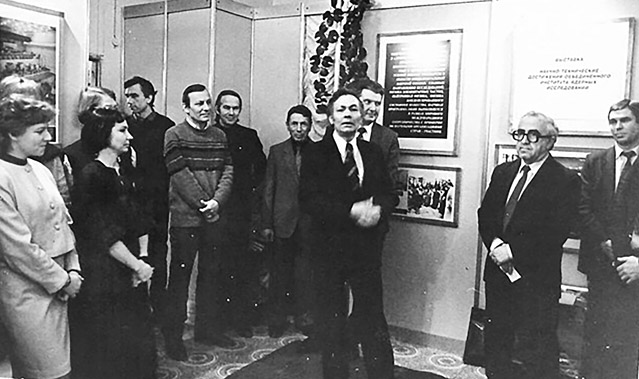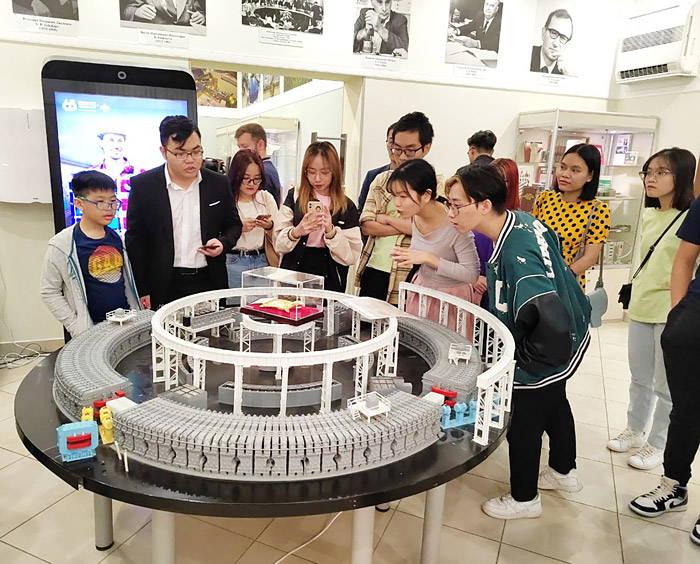
Electronic english version since 2022 |
The newspaper was founded in November 1957
| |
Keepers of history
13 March marks the 30th anniversary of the establishment
of the JINR Museum of History of Science and Technology
It was headed by a professional physicist and just as professional poet Genrikh Lyudvigovich Vardenga. The employees of the oldest natural science museum in Russia, the Polytechnic Museum helped him and his colleagues.
Shortly before that, presenting the programme for the reconstruction of the Polytechnic Museum, its Director Professor G.Grigoryan had written: "...The Museum of Science and Technology is capable of educating by training. A person should leave it with an increment of knowledge. And not random, but systematized. After all, knowledge can be chaotic and well-ordered, suitable for practical use... Every person, regardless of whether he is a technician or not should learn about the museum. It helps him to live in the world of technology as in a natural environment."
To a large extent, this programme formed the basis of the concept of the Institute's Museum. Veterans of the Institute, members of the scientific community helped with advice, exhibits and particular case. Directorate allocated a cozy room that once was housed by the Communist Party Committee. And this small building, next to the first Music School, became a kind of information and cultural centre: for several years the Museum has shared premises with the editorial office of the JINR Weekly "Dubna".
When the cause lives and wins, one can already recall with a certain smile the heated debates at the level of discussions. What should the JINR Museum be like - an archive, a warehouse of exhibits, or one of the factors of future acceleration? Who needs it - the elderly or the young? "Do we need a museum at all?" a veteran of the Institute, by no means a technocrat, but an outspoken and even humanitarian person, not alien to literary creativity, an avid theatergoer has asked me. I have never expected it from anybody but from him. And really, I thought what if one doesn't need it?
Yes, you need it! This was the general opinion of the participants of the discussion held in the JINR International Conference Centre. But there were a lot of opinions on what a museum should be. I will cite just a few ones.

At the opening of the JINR Museum exposition in the Polytechnic Museum. Speaker V.A.Nikitin.
Professor V.A.Nikitin, Head of the Sector at the Laboratory of High Energy Physics: It seems to me that the future museum can become a club of interest. A permanent seminar on the methodological problems of science can be held here. New knowledge, as you know, is born on the basis of a broad scientific and cultural context. A museum should show not only benefits, but also drawbacks of one or another chosen scientific area...
Professor G.A.Ososkov, Head of the Sector of the Laboratory of Computing Techniques and Automation: But the museum is meant mainly for young people. I have talked to some already "experienced" young specialists in our laboratory and have heard: who needs a warehouse of dead things? So I would like to see a discussion club in the future museum. Exhibits and materials are like signposts at the crossroads of history at its defining moments. For instance, our laboratory has existed for more than a decade. Everyone feels that something needs to be done to make it develop. This is where an analysis of past mistakes and misconceptions can help.
Professor V.A.Khalkin, Head of the Sector of the Dzhelepov Laboratory of Nuclear Problems: The museum is a repository of material evidence of the path we have travelled, of scientific instruments that have helped to do good work, inventions and discoveries. For instance, the first movable reflector of the world's first pulsed reactor. It should be a museum of bright scientific thought. Why did major statesmen, prime ministers of many countries travel to Dubna in the early years of JINR? It was the centre of world scientific thought. Returning the Institute to its former glory is the task of future generations of scientists. But they need to be educated on the best examples of our history.
A.N.Kharin, an engineer of the Laboratory of Ultrahigh Energy: Somehow, we have not yet said anything about what JINR has once determined and I hope, even today, in many ways it determines the face of the city of Dubna. Remember the film "Nine Days of One Year" - after all, it is about our Institute, too and it was filmed in Dubna... It seems to me that the museum can show who the modern scientist is, to help to trace the origins of JINR, where V.I.Veksler, I.V.Kurchatov and other outstanding scientists of our country stood.
Thus, truth was gradually born in arguments and after a public discussion on the issue "what should the Institute's Museum be like?" I again met with the "doubting man". Without saying a word about our previous conversation, he remembered... about a perfectly operating mechanical model, illustrating the principle of operation of the synchrophasotron: "Maybe somebody still has this model? It would be a pity if it has gone to waste..."
The Museum has also benefited from the fact that Dubna is an international city and we have so many various guests... Professor Vladimir Alekseevich Nikitin, by the way, the recently replaced Chairman of the Public Council of the Museum that has worked for several years at the Fermi National Accelerator Laboratory in Batavia, invited his colleague Professor Ernest Malamud from the United States to Dubna. In 1987, the well-known experimental physicist, scientific leader of young researchers came up with the idea to establish a museum of science and technology. In 1988, he organized the first exposition. In 1989, the Museum welcomed its first visitors.
Why did the famous physicist decide to mind "not his own" business? The guest from the United States disagreed with such a formulation of the question: who, if not scientists, should be engaged in the promotion of science? And for him, this is not even a hobby, but a need of the soul. In the region where Fermilab is located (as the scientific centre in Batavia is called in physical vernacular), there would seem to be no need for another museum exhibit. It's a stone's throw from here to Chicago, home to the Museum of Science and Industry, with 200 staff members and 4 million visitors a year. The competition is out of the question here. However, even from fiction, we knew about the "local patriotism" of Americans that are used to being proud of the sights of their native places.
When the traveling exhibition, organized by Professor Malamud and his companions, arrived in one of the small towns of the district, the first to notice it were "their" boys that happened to be there either for scouting camps or for sports competitions. It is hard to think of a better advertisement. They were running around town shouting: "The exhibition is from our town! We've seen it! Don't miss the chance!"
You can (and should) touch everything in this Museum. You bring a strong magnet to a pretty announcer's face on the TV screen - and the face is distorted by a bizarre grimace: "crazy TV" illustrates the principle of the accelerator - the deflection of charged particles in a strong magnetic field. You can become the owner and master of a small whirlwind "tornado" or the director of a bright show with dancing laser beams... And among several dozen objects on display, there are also a "quark machine" illustrating the structure of elementary particles, an "isotope valley" and other functioning exhibits, made by students of higher schools and colleges, transferred to the Museum by organizations and individuals.
"We have many high-tech industries, but the pace of scientific and technological development is so high," E. Malamud said, "society cannot always keep up with the changes that take place. And above all, young people need to be prepared for this. How to prepare them? There is an old Chinese proverb: "I hear and I forget, I see and I remember, I do and I understand." A museum should be a research laboratory, where each visitor will make more than one discovery that clarifies the laws of nature."
...But let me return to the meeting of the members of the JINR Museum Council with their American colleague. Professor Ernest Malamud and museum employee Olivia Diaz spoke about the creation of museum expositions at Fermilab, at the Oppenheimer Laboratory, as well as at a number of other scientific centres in the United States. This trend reflects, on the one hand, the desire to understand the role of science in modern society and on the other hand, the importance of bringing scientists together to advocate for its development.
After all, a museum is not necessarily a gallery where yesterday's merits are registered and parade portraits are displayed, it is a laboratory in which all visitors have a serious, respectful attitude towards science and scientists. And it's good that when establishing such a laboratory, its organizers are guided by the best practices of the world's leading scientific centres and the initiative of individual scientists-enthusiasts.

Vietnamese students at the excursion in the Museum.
Today, the exposition of the Institute's Museum includes many valuable exhibits. As expected, research is also carried out here. Almost every laboratory has branches of the Museum - these are memorial rooms where Academicians N.N.Bogolyubov, B.M.Pontecorvo, I.M.Frank and G.N.Flerov worked. The Museum has become a meeting place for veterans.
Our newspaper writes a lot and willingly about vivid scientific and educational projects that attract many schoolchildren to the Museum, about the popular science lecture hall "Accessible Science", about the "Laboratory of Scientific Experiments", about "Mendeleev Readings", historical and scientific seminars and many other activities. And we hope that there are a lot of new meetings and discoveries ahead and for those who have not yet visited the Museum, we can advise to visit its website http://museum.jinr.ru/. Come to visit it, you won't regret it!
And the address of the Museum is 2 Frank Street...
Evgeny MOLCHANOV,
from the book "Conversations about Dubna", JINR, Dubna, 2003.
Today, Genrikh Vardenga, Nadezhda Kavalerova, Anastasia Zlotnikova, Kirill Kozubsky, Aleksandr Rastorguev work in the Museum. We wish the jubilees bright creative success in popularizing science and technology!